Did you know that the average user reads between 20 to 28% of words during an average visit on a site (Source: Nielsen Norman Group)? What’s more shocking is that blog posts are the most skimmed content on the web – With over 43% of users skim reading them:
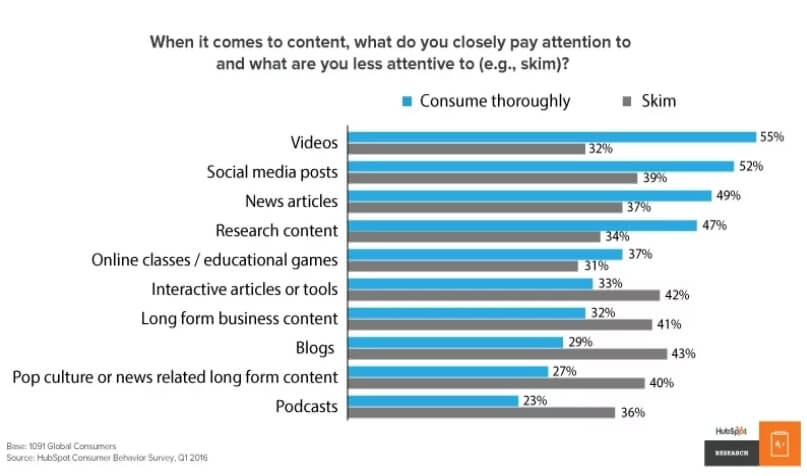
(Image taken from Hubspot)
Looking at these long-form content stats, you would think what’s the point of even creating long content? Especially if most of the content won’t even be read! Just think about the last time you read an entire long or short blog post all in one go… The chances are you might have skimmed it, but never actually read it word-to-word.
So you see, long-form content serves a greater purpose than just being read. It could benefit your entire content strategy in many ways. This guide will explain exactly why long-form content is important to SEO and how to write your own long-form content. (also see our Guide to Content Marketing Ideas here.)
What is Long-Form Content?
Long-form content can differ depending on who you ask. Some SEO experts might say any article longer than 600 words is long-form. While others might say you need at least 2,000 words to make your content long-form.
One thing that almost all long-form content has in common is detail. Whatever the topic, long-form content goes into great detail explaining that subject. In general long-form content can be easily identified by its title. For example the title may include:
- The ultimate guide to…
- Everything you need to know…
- What is….
It may also refer to broader topic ideas, such as a blog post on the basics of SEO or having a whole page dedicated to ‘Toy Story’:
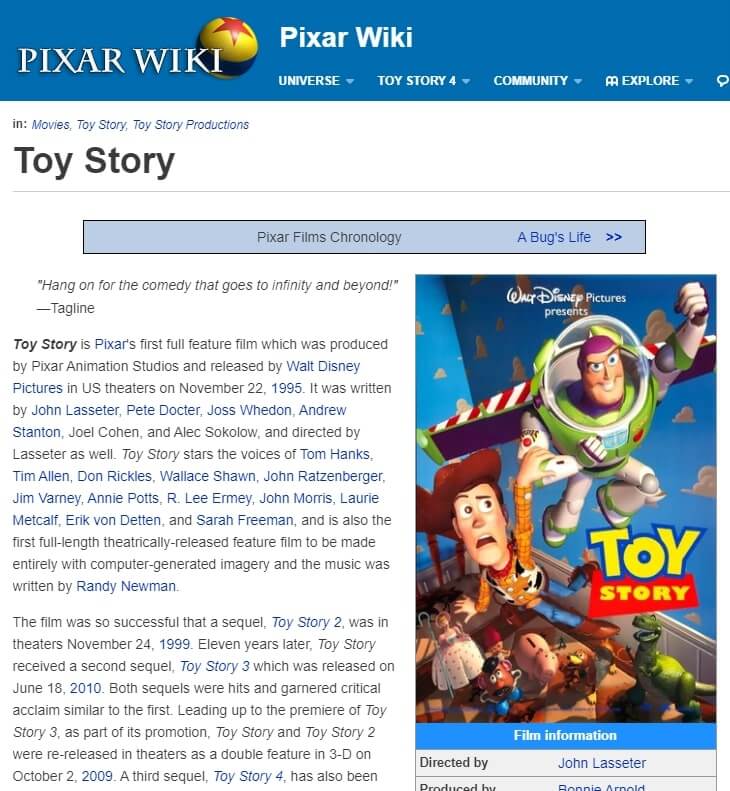
Ultimately, the purpose of long-form content is to tell you everything you need to know about something. This may include, background, history, addressing commonly asked questions and so on.
The average long-form content length
The definition of long-form content is pretty straight forward, as it’s all about detail and word count. But what is the optimal amount of words needed for an article to be considered long-form? Now this is the real question!
And the answer, in our opinion, depends on a number of factors including, keyword, industry, competition and your target audience.
To illustrate this point, let’s take a look at two search queries from two very different industries. Here are the top page one results for both queries along with their word count:
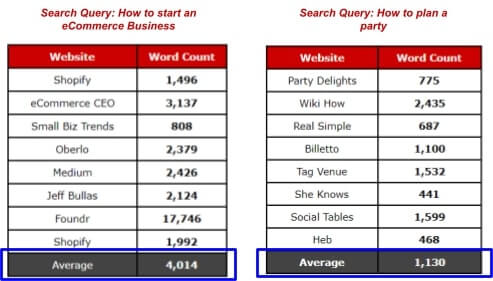
It looks like business-related articles tend to be much longer in length than lifestyle posts. So, if you wanted to write a long-form article on starting an eCommerce, you would want to aim for around 4,000 words.
Alternatively a long-form content in the party planning sector would be around 1,000 words.
Another factor that could impact the optimal word count is keyword intent. Take a look at this comparison of two queries and their top ranking pages:
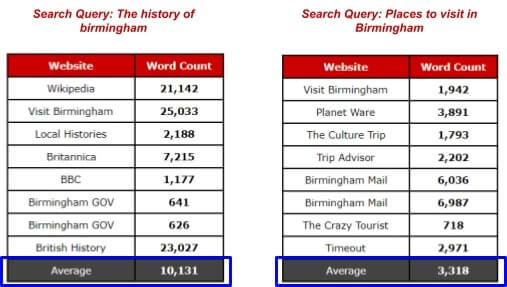
For someone researching the history of Birmingham, they are more likely to be interested in in-depth content. For this reason, 10,000 words would be considered as long-form content. On the other hand, looking for places to visit in Birmingham requires less detail. In this case around 3,000 words would be considered long-form.
FOCUS ON USER INTENT
So you see, it is difficult to define what exactly long-form content is, since it can be based on a number of factors. But if you’re looking for a general number, Backlinko did a huge study on analysing over 1 million Google search results. In this study they found the optimal number for blog posts to be around 1,890 words.
So we’d say that somewhere around 2,000 words is a good place to start when creating long-form content for your site.
Types of long form content
In our definition of long-form content above, we primarily focused on written content, such as blog posts or articles on your site. However long-form content refers to much more than just blog posts. It can refer to videos, social media posts and other areas of content marketing.
Here are a couple of examples of long-form content, along with their recommended length:
Videos
When talking about long-form video content, we are generally referring to videos with a beginning, middle and end. Take this example by IGN and their YouTube video on Nintendo’s history:

This video tells the story of Nintendo’s gaming history in 19 minutes. Starting from the 1980’s to the current year. In most cases, long-form videos are similar to mini documentaries, explaining huge phenomenons or presenting interesting facts on a topic.
On average a long-form video on YouTube is at least 10 minutes long – some may even go up to an 1 hour. But it’s important to bear in mind that the attention span of a typical YouTube watcher isn’t very long – so the shorter the video the better for viewers. But not too short – otherwise the video would be pointless!
Facebook Content
Most people seem to forget that Facebook allows you to post really long status updates or content. In fact, in 2020, a Facebook post can be as long as 63,206 characters. That’s obviously much higher than Twitter’s limit of 280 characters!
With plenty of characters to play with, what does long-form content look like on Facebook? On Facebook long-form content can refer to video and written content. For example, ‘How-to’ type of videos are a very popular form of long-form videos on Facebook:

Similar to YouTube, long form Facebook videos tend to be around 10 minutes.
Alternatively when it comes to written content, it almost never reaches the 63,000 character limit. Instead most Facebook users make use of the extra space to format their long-format content nicely with emojis (like this example from Buffer):
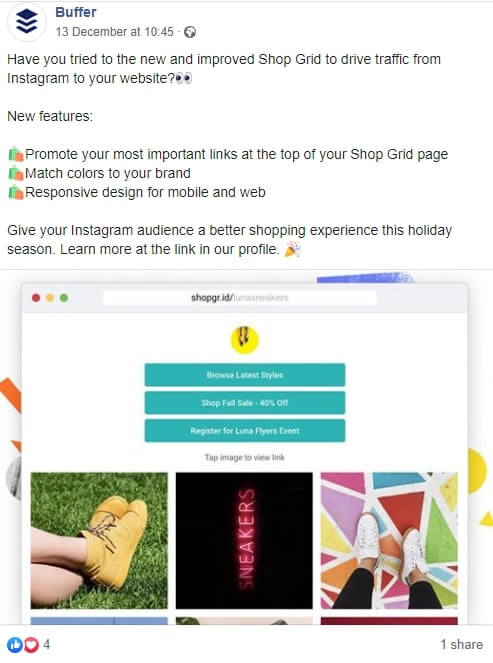
This post is just over 380 characters long – Not quite hitting the character limit, but it’s still pretty effective!
Quora Answers
One online community that thrives on long-form content is Quora. The highest voted answer, for almost all questions on Quora is normally long-form. Just take a look at this example:
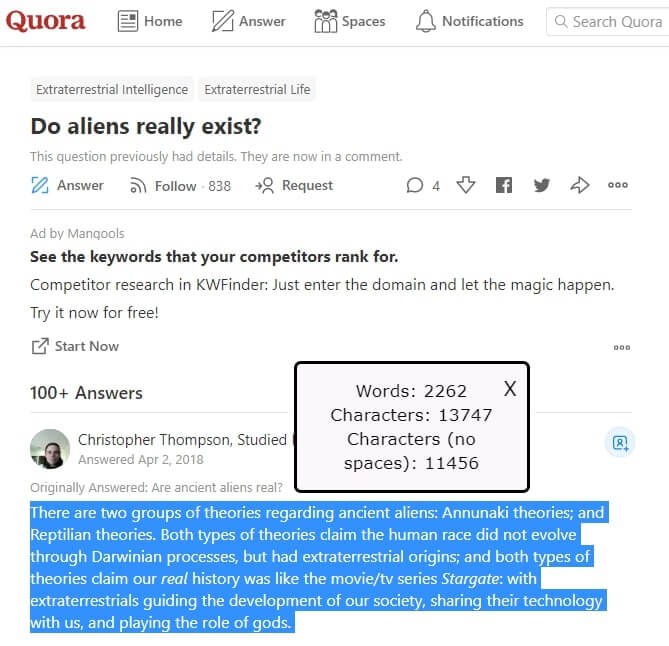
The top voted answer is over 2,000 words long – That’s similar to the length of a typical long-form blog post. A simple ‘yes’ or ‘no’ is the worst response on Quora!
In fact, after reviewing a bunch of random answers, we recommend a length of 800 to 1,000 words (at least) to provide a good answer on Quora.
SoundCloud Audio
You guessed it! Audio files, music or podcasts can also be considered as long-form content, if they are long enough. Take this podcast example on Soundcloud:

It’s just over 1 hour long, making it a typical long-form podcast. Of course when it comes to music or songs, you expect this length to be a lot shorter. Typically around 5 minutes. Although you may get 30 minutes of some relaxing music, like in this example:

So even in the world of audio there is long form content to consider!
TV Shows & Ads
Going back to traditional long form content – TV is the king of long form video content. Unlike YouTube or Facebook, long-form content on TV is typically between 2 to 3 hours long! Of course, here we are talking about movies or award shows as the common examples.
Whereas TV shows ranging between 20 to 30 minutes are generally considered to be short-form content on TV. Examples of these may include cartoons, soaps and even the news.
Alternatively, when it comes to TV ads, something over 2 minutes would be considered a really long ad on TV. A famous example of a long TV ad, would be those John Lewis Christmas ads! Like this 2019 Christmas ad, featuring Edgar the Dragon:

Of course they have the alternative short-form versions of those ads which are between 15 to 30 seconds. So they are not constantly taking up too much ad space on TV.
So you see long-form content is a broad term that can be applied to all areas of content marketing, from written content to videos and audio files. And it can be applied to all sorts of platforms from social media to TV.
In this guide, we will completely focus on written long-form content and primarily refer to blog posts or articles.
Is Long-Form Content important for SEO?
In short, yes! Long-form content is full of depth and aims to answer multiple user queries in one post. People might not read an entire long-form blog post, but they will definitely find value somewhere in it.
From an SEO perspective, there are many benefits of creating long-form content for your website. Some of these benefits include:
- Ranking for a variation of keywords
- Increased chances of social sharing
- Higher chances of getting backlinks
- Increased time spent on site
- Overall improved domain authority
Let’s explore these benefits in a little more detail.
Ranking for a variation of keywords
When explaining something in great detail, you’re likely to include a range of keywords relating to that topic. Not only does this help Google determine the relevancy of your content, it also helps you rank for a number of keywords (especially long-tail queries).
Take a look at this long-form article on Pixar:
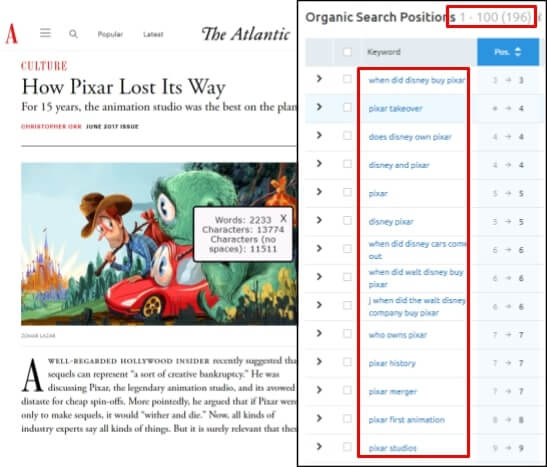
This 2,000 word article ranks for nearly 200 keyword variations.
Alternatively this shorter 500 word article on Pixar history, only seems to get organic traffic from one keyword:
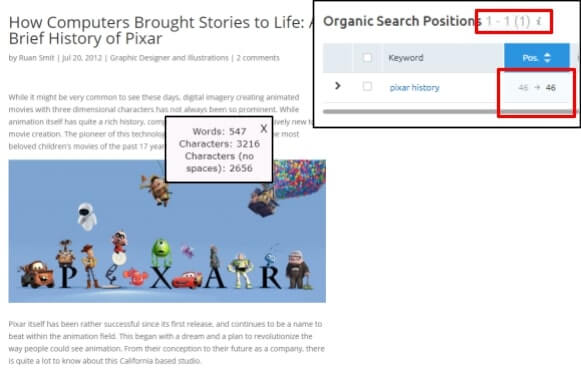
This shorter article ranks in a lower position for only one keyword. While the longer article ranks for a number of keywords in mostly high positions.
By creating long content you not only have the chance of ranking for multiple keywords, but you could also improve your overall rankings by including these variations.
Increased chances of social sharing
Many studies have shown that long-form content has a much higher chance of being shared on social media compared to shorter articles. For example, In 2015 Moz teamed up with Buzzsumo to analyse the social shares of over 1 million articles on the web and their findings were quite surprising:
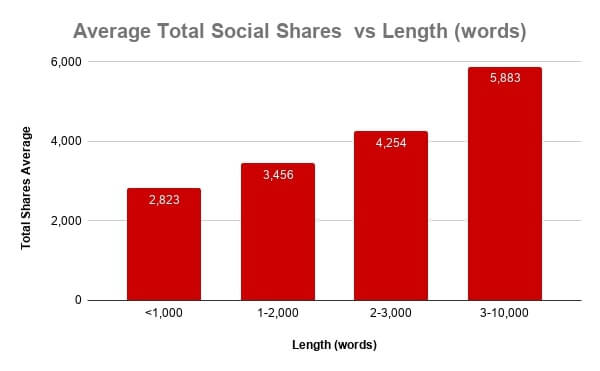
It seems the longer the article, the more likely it is to be shared on social media. So why are long articles more likely to be shared? In our opinion longer articles seem to solve more problems compared to shorter ones. And as so many problems are being solved with long-form content, users are more excited to share them on social media.
Another point to make is that short form content normally provides a generic, to-the-point answer which doesn’t really surprise or excite users into sharing the content. While long form articles are more likely to provide some interesting insights into a topic, giving users a bigger reason to share them.
To put this theory to the test, we ran a quick analysis of our own. We searched for the query, ’tips for moving house’. Then we selected one short article and one long-form article.
The short article with a word count of over 600 words by Zoopla does have over 200 social shares:
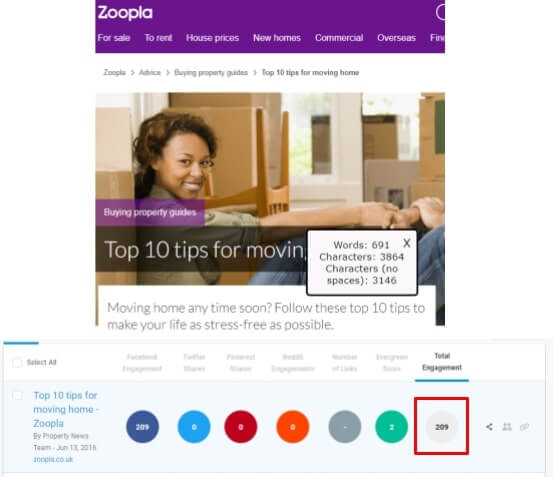
However the longer 2,000 word article has twice the amount of shares (over 400 shares):
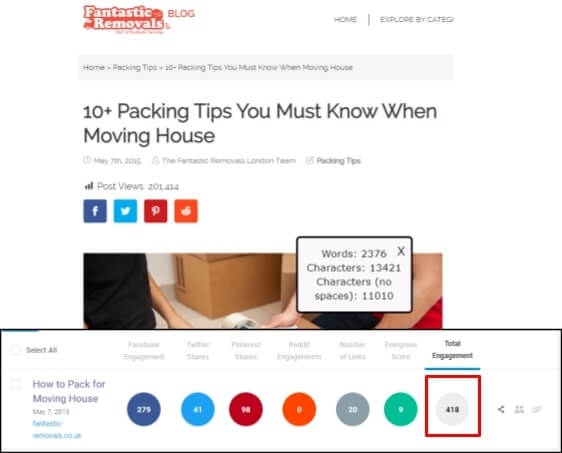
If social shares are important to your business, then it’s time to get started on some long form content for your site!
Higher chances of getting backlinks
Similarly to getting more social shares, longer content is also known for getting more backlinks to your site. To prove this point, Backlinko’s Brian Dean did a study of over 900 million blog posts. In this study, he found a direct link between backlinks and content length:
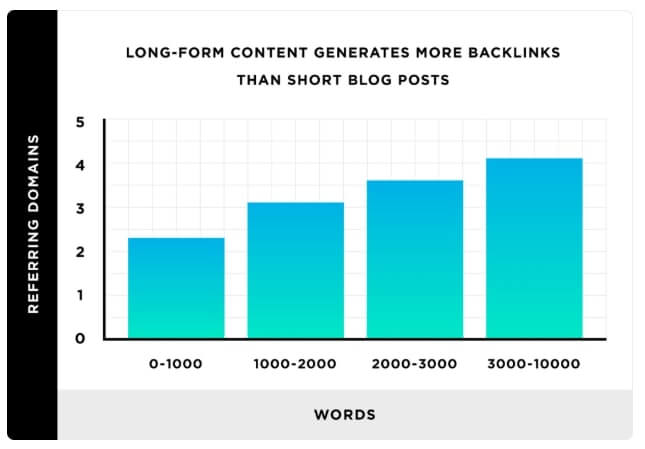
(Image taken from Backlinko)
So it looks like longer content also gets more backlinks and why is that? The answer is similar to why longer posts get more social shares.
Longer content tends to provide more useful insights into a topic compared to shorter content. It is this useful insight that encourages most website owners to link to long form content.
In addition to this, longer content seems to do a better job at demonstrating your expertise in a particular topic or field. For this reason users tend to trust longer content more than shorter content. It is also this trust that might encourage someone to link to your long form content.
Here is an example to illustrate this point. We compared the backlink profile of two blog posts on growing tomatoes. The first site has around 600 words, while the second site has nearly 1,500 words:
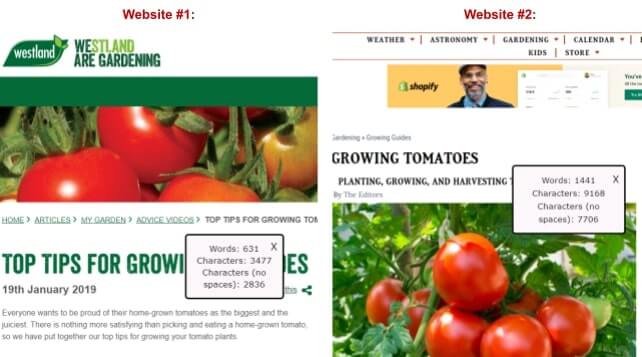
And here are the backlink profiles for both the sites above:
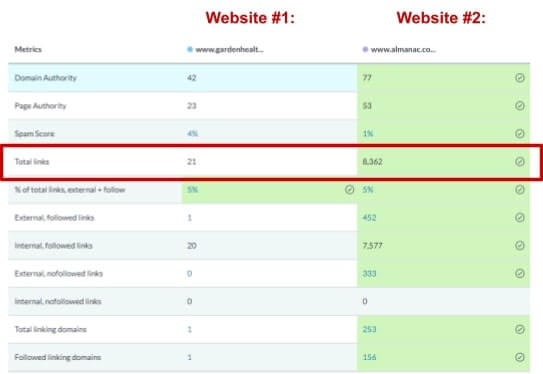
You can clearly see that website #2 (1,500 words) has much more backlinks compared to the website #1 (600 words).
This along with many other studies on the internet proves the point that long form content gets more backlinks than short form content.
Increased time spent on site
Time spent on site, along with dwell time is a key ranking factor. Dwell time is the time between a user clicking on a search result in Google and then returning back to the Google search results page. Some SEO experts call this ‘pogo-sticking’ – When a user moves between different results on the results page.
This might be a no-brainer, but long form content increases the chances of having a longer dwell time. The reason for this is simple – Longer content has more information to digest. There is also a higher chance of the user finding the answer they were looking for, lowering the risk of ‘pogo-sticking’.
To illustrate this point, here’s a little case study by WordStream.
WordStream did a little experiment to see how long form content affected the average visit duration on their site. From late 2012 when they started creating long form content they noticed a steady increase in their average duration:

(Image taken from WordStream)
And so by creating long-form content, they were able to increase their average visit duration from 1:33 to 4:35 in under one year. This proves the impact on long form content on page engagement factors, like time spent on page and dwell time. And this all contributes to the organic ranking of your article in search results.
Overall improved domain authority
Domain Authority (DA) is a metric that was developed by Moz to predict a page’s ability to rank in search engines. A score of zero is bad, while a score of 100 is brilliant. Many SEO experts believe that long-form content can be used to improve your site’s domain authority.
This theory makes sense because of all the other benefits of long form content. When you combine engagement factors, social media links, backlinks – Then your domain authority is very likely to improve.
However there is no clear evidence or studies out there to prove that long form content directly improves domain authority. We even studied a small sample of blog posts using the query, ‘taking care of a hamster’ in Google. And we couldn’t any clear pattern between word count and domain authority:
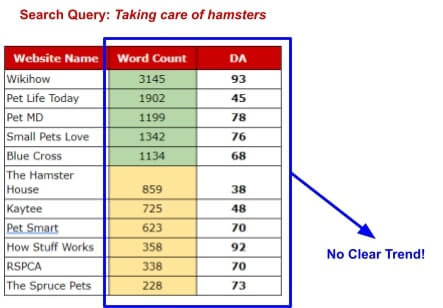
For this reason long form content may improve your domain’s authority, but only indirectly. But we can never know for sure!
How to write long form content
Now that you have all the necessary background information on long form content, it’s time to get writing. Here is the simple process we follow at Fastfwd to create long-form content:
1. Pick an evergreen topic:
Long form content should be suitable to read at any time of the year. This is really important! You don’t want to write 2,000 words on a seasonal topic that no-one will read in a year’s time.
It should also be a very broad topic and not something specific like, “Cinderella’s step sister’s name”. Who can write 2,000 words on that! Instead you might just want to select, “Cinderella” as the topic. After all it’s a lot easier to write 2,000 words or more on broader topics than specific ones.
2. Research your target keyword:
Using a keyword research tool of your choice, find some related keywords to this topic. Here at Fastfwd we use SEMrush to research our keywords. Using SEMrush’s keyword magic tool we are able to find a list of related ‘Cinderella’ keywords:
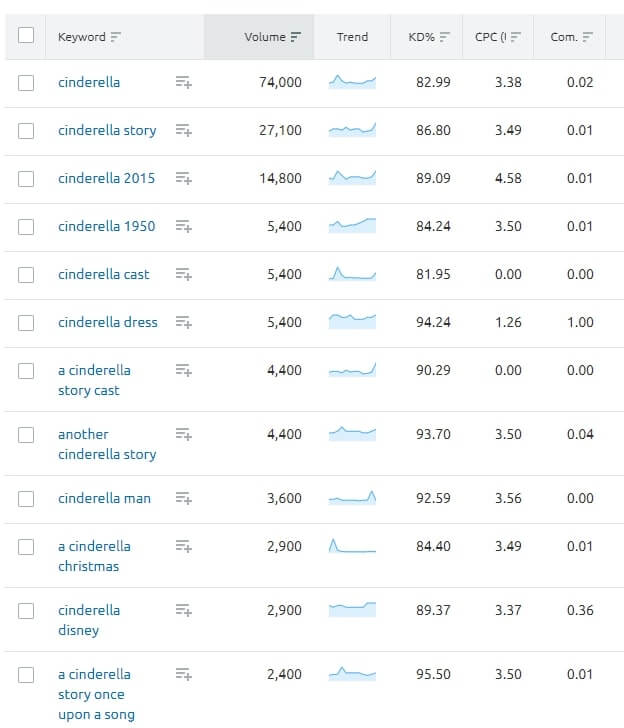
Now when it comes to long form content, you would ideally want to pick a target keyword with a high monthly search volume. In this example, we might find the broad keyword, ‘Cinderella’ too competitive to target. Especially if you’re a new site lacking in authority. So instead we’ll go for a long form article on ‘Cinderella Man’, which seems to be more reasonable.
For more help in this area, read our article on how to do keyword research.
3. Find variations of your focus keyword:
Similar to the previous step use your keyword research tool, to find variations of keywords relating to your focus keyword. In our case we found the following variations in SEMrush:
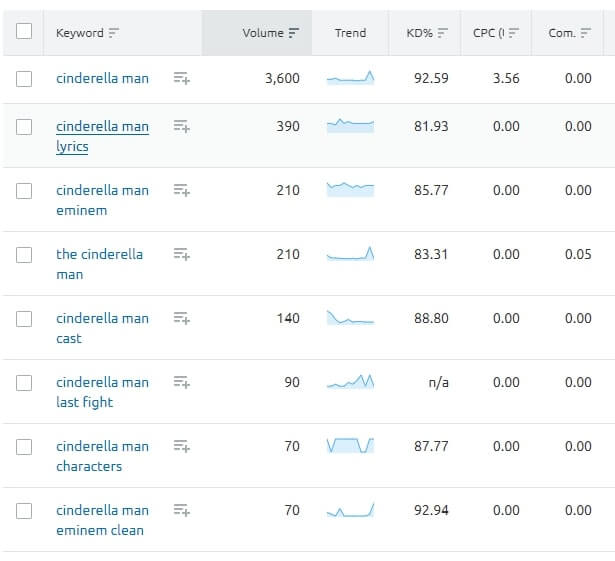
SEMrush even lets you filter by questions, so you can see the types of questions users are searching for relating to your focus keyword:
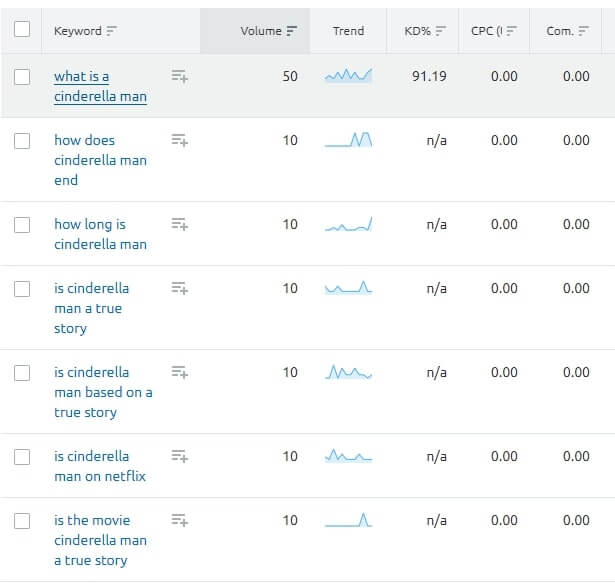
Now that you have a list of related keywords and long-tail phrases, you’re ready to start planning your long form content design and structure.
4. Plan out your long form content design:
It’s time to start organising your keywords into a suitable long form content structure. One way to do this is by starting with the higher volume keywords at the top and then working downwards.
Ideally you would want to include some of the keyword variations into the subheadings of your long form articles. Take our example of ‘Cinderella Man’, we would structure the article something like this:

As you can see this structure addresses almost all the top keyword variations relating to the target keyword. And that’s the key to having good long form content – Addressing all the concerns that a typical user would have on that topic.
5. Get Writing:
Now that you have the perfect content structure for your long-form article – all that’s left to do is to write it up! Sometimes it’s nice to have a word count goal in mind when writing long-form content. That’s why we suggest Googling your target keyword to see what comes up and the length of top ranking articles:
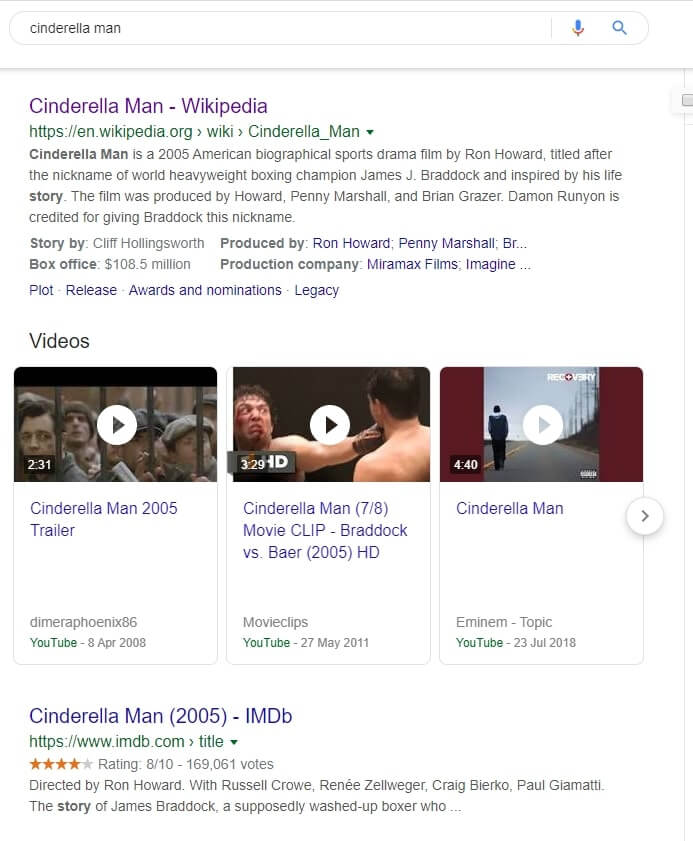
A quick look at the top ranking pages has shown us that the ideal article length we should aim for is between 1,000 to 1,500 words.
It’s not just length that is important. You might also want to look at how your competitors have formatted their content. For example have they used bullet points, galleries, sub-headings and so on.
By following these 5 simple steps you should find the process of writing long form content a lot easier than before!
Long form Content Best Practices
Long form content is a time consuming job and that’s why it is important to follow these best practices. These best practices will help you create the best long form content for your site that is possible!
- Choose the right content structure:
Depending on your topic of choice big chunks of paragraphs won’t always be effective. Instead you might want to experiment with list-based articles or a Q & A type format. Remember it all depends on your audience and competitors! - Make life easier with a table of contents:
Long form content can be super long, making it difficult to navigate to the right section. You can make life easier for your readers by including a table of contents at the beginning, allowing readers to jump to the section they need. - Sub-headings make skim reading easier:
It’s so ugly seeing paragraphs after paragraphs of text without no sub-headings. Not to mention extremely difficult to read. We highly recommend including relevant sub-headings in your long form content which utilise related keywords. - Study your competitors:
The biggest inspiration for your long form content will come from your top-ranking competitors. Look at their content structure, length, number of shares, backlinks and anything else that will inspire you. - Research the right keywords:
Keywords are very important in long-form content. After all an article that took you weeks to write, should give you the return of ranking well in Google at least! - Look out for featured snippet opportunities:
Long form content gives you the opportunity to address specific queries from users. During your keyword research keep an eye out for keywords with a featured snippet in the SERPs. Then you can upgrade your article to target these snippets. - Use relevant call to actions:
As mentioned earlier long form content is a good way to build trust with your readers and demonstrate your expertise. While your readers are engaged with your content, it would be a waste not to include relevant call to actions to related services or products. - Consider gated content:
Gated content is when a user needs to provide their email address or login to view. Since you spent ages writing this content, you might want to get some valuable leads from it. If you do, then we suggest providing some sort of preview and then asking people to provide their email address to read the rest of the article. - When is long form content too long?
Your content is probably too long if you find yourself babbling about something pointless. Remember your long-form content must contain value at each section. If you have nothing valuable to say then don’t write it. In terms of a number, there is no ideal word count number as mentioned at the beginning of this post – It all depends on your competitors, industry and target audience. - Long form content performance:
Once published you need to keep an eye on the performance of your long-form content. Some metrics you might want to track include, the new visitors this post brings in, organic traffic, average time spent and bounce rate. This will help you determine whether your long form content was worth the effort and how it can be improved further.
And if worst comes to worst, you can always work with a professional content marketing agency to help you plan out and create your content.
Long Form vs Short Form Content
Long form content seems to be something most SEO agencies are recommending right now. But does all content on your site have to be long-form? The simple answer is no. Imagine the time it would take to update all your pages to be at least 2,000 words long – that sounds like overkill.
Long Form Content
So when is long-form content suitable? Long form content is brilliant for building trust with your audience. It is the type of content that would be brilliant for lead generation. Especially if it’s gated content. Take for example eBooks, webinars or how-to guides.
Long form content is normally about general, informational topics and not relating specifically to your company or products. For this reason, long form content is good at engaging potential customers at the beginning of their buyer journey. At the point where they have just discovered a problem and are researching potential solutions:
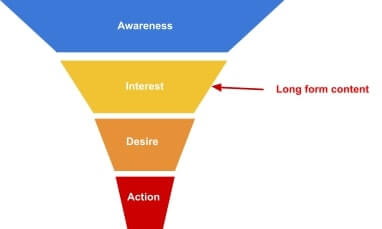
As you can see long form content is the thing that moves a typical user into the ‘interest’ phase. It is the moment when a person has a problem and then they discover your article, video or other long form content. As they interact with your long-form content they become engaged in your company (that’s if your content is good).
With clever use of call to actions and internal linking, you might even be able to push this user into the ‘desire’ phase. The phase where you built enough trust with the user to stand out from the competition.
Lead generation landing pages are a good example of long-form content created to build trust and generate leads. Just take a look at this example Renegade’s landing page:
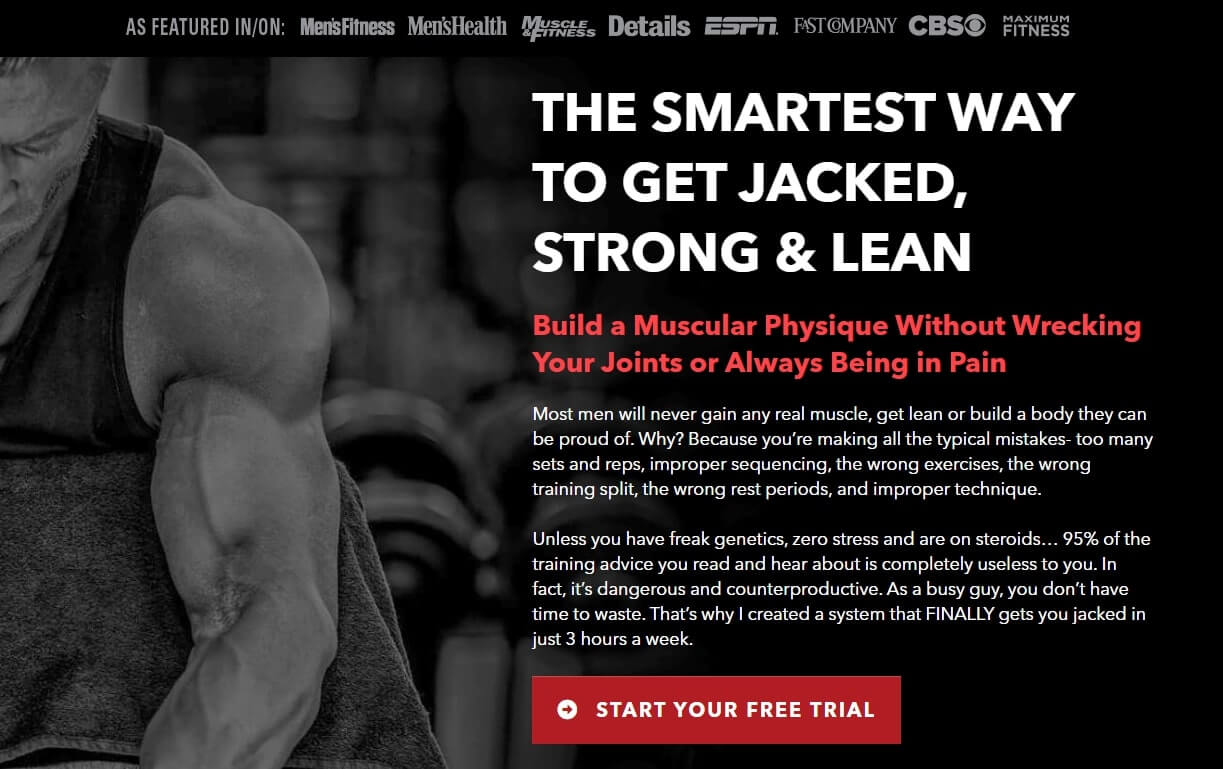
It has over 3,000 words encouraging users to start a free trial on their muscle building course. As part of their content, they cover testimonials, benefits, common questions people ask and more to remove any doubt a person may have. The goal here is to clearly generate a list of leads which can then be nurtured into the action or buying stage.
There is a situation where you would avoid long-form content. And this situation is mobile optimisation. Long-form content is normally not read on mobile devices because the smaller screen size can make reading long content difficult. Instead users typically bookmark it to read later – But then forget about it!
If you know that a piece of content will be designed specifically for mobile users like app content, then you might want to look into shorter-form content.
Short Form Content
What about short-form content? Short-form content is normally under 300 words. Common examples of this might include tweets, status updates, bite-sized articles or a quick answer on a forum.
The purpose of short-form content is to clearly provide an answer or confirm something previously stated. Take for example on your site, you might use short-form content on the check-out page, about us page or even on the register page.
Short form content is very common on eCommerce sites, particularly on the category pages where you might only one paragraph to describe the category:
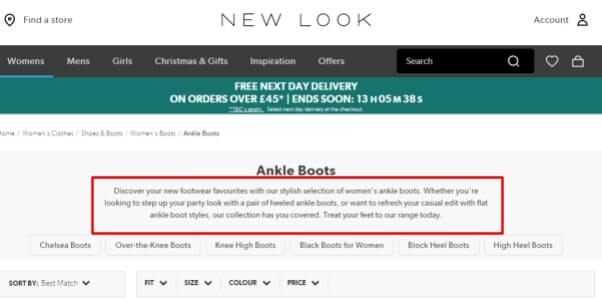
You could even say that short form content is mostly used in a situation where the user is ready to buy. They have made their decision and are ready to click the ‘buy now’ button. At this point a couple of testimonials and bullet points will be enough to tide them over:
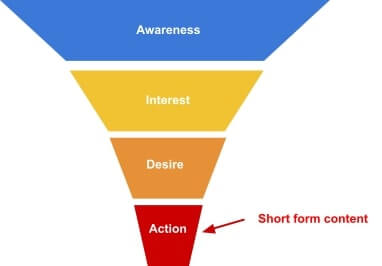
With short form content there is normally no need to convince the user to do anything, as they already know about you and your products. This is the time to confirm their beliefs in you and give them quick answers to any questions.
Of course there are times, such as with Twitter tweets where short form content contributes to the awareness and interest phase of the buyer’s journey.
Summary: Long Form vs Short Form Content
Now that you know the difference between short and long form content – Here is a summary of both:
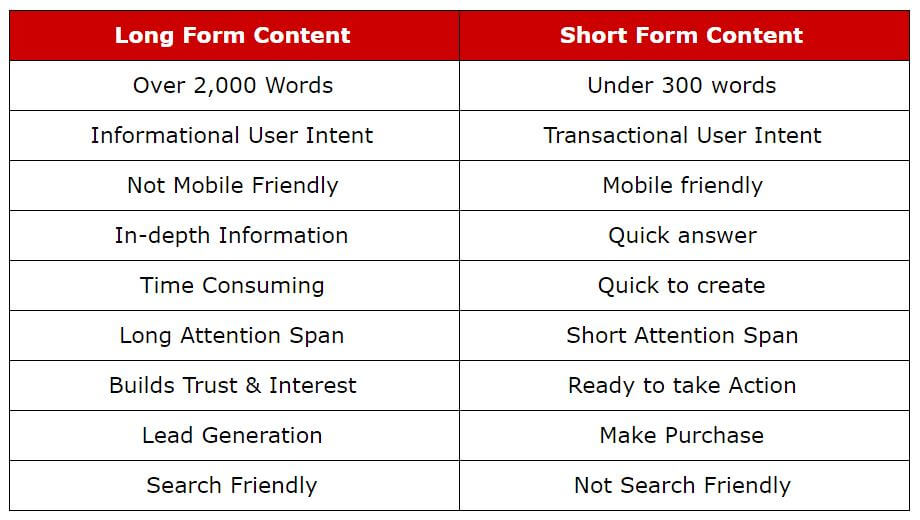
(Please bear in mind that this is a general summary of both types of content – There are definitely times when the lines between them get blurred.)
Hopefully by now you can see that there are definitely times when your site needs long-form content and there are times where you’re better off creating short form content. It all depends on your goals, target audience and how much resources and time you have.
Long Form Content – Do you Need it?
Don’t get us wrong – Not every page on your site needs to have at least 2,000 words. In fact there are situations where fewer words would do a better job. Take for example an eCommerce product category page – No-one wants to read thousands of words here, they just want to view your wonderful products. Always keep your audience in mind when creating content. Put yourself in their shoes and ask yourself, how much information do they need on this topic? And which would be more suitable short or long form content?
Are you interested in creating long form content for your site? Contact our team for help and advice on creating and planning long form content.
